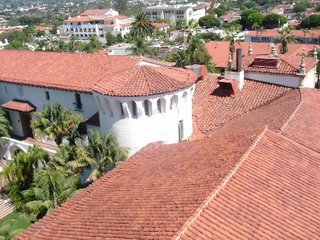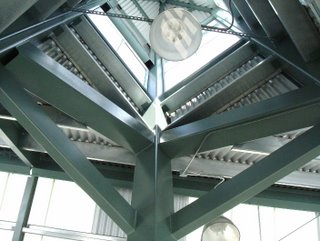
The thing labor needs most?
A long and wonderful vacation.
I am back home from my 2006 trip down the west coast. This was my 5th west coast tour over the years.
Came back by train.
Above picture taken from observation tower atop Santa Barbara County Courthouse. Downtown Santa Barbara has a lot of classical architecture and pedestrian malls.
A similar view was featured in the popular book "Bicycling The Pacific Coast" by Tom Kirkendall and Vicky Spring, (at least in an earlier edition). I remember pouring over that book before my first west coast trip in 1987.
Cyclists are still taking that book with them as they do this trip. (Probably later editions).
At the end of my trip, the radio said that California has just passed a strong piece of legislation designed to roll back state wide greenhouse gas emissions. Roll these back to 1990 levels by 2020.
That will be a tall order as one must remember, population is also increasing.
Just "treading water" (keeping same percapita consumption levels) means increasing consumption if population is increasing.
This will require some major changes.
Or, maybe the goal can't be achieved with conservation? Nuclear power anyone? How about solar? Hydrogen Fusion?
All of the above.
Ironically, southern California seems more bicycle friendly than northern California. More people and more money for infrastructure. Also the need is clearly evident.
Things like bike paths and the southern California Surfliner train are great.
Now, back hear in Washington State, the Dave Ross Show, on Seattle's KIRO, does a segment about how to make roads safer.
Labor Day weekend is a deadly weekend on the roads.
Many kinds of suggestions come in. People suggest things like making truckers only operate at night or having the driving test become harder.
No one mentions making the nation less dependent on automotive travel. Maybe I should have called.
Looking forward to adding photos and stories, from my 2006 trip to these sites in the next few months.


